Wearable security alarms for seniors offer discreet yet powerful protection, with a focus on loud and distinct best personal alarm sound to grab attention quickly during emergencies. Devices should have a strong signal within a range of up to 1000 feet (300 meters) and be customizable for individual preferences, including adjustable volumes and tones. Key features include ease of use, long-lasting battery life, water resistance, and durability, ensuring maximum convenience and reliability in various environments while prioritizing best personal alarm sound distance. Regular charging, testing, and understanding the user interface are also vital for optimal effectiveness.
Staying safe as a senior is paramount, and wearable security alarms offer a discrete yet powerful solution. This article guides you through understanding these innovative devices, which can provide peace of mind while promoting independence. We’ll explore key features like loud, long-range personal alarm sounds crucial for immediate assistance during emergencies. Best practices and tips ensure optimal use, empowering seniors to stay safe in their own homes. Learn how these devices can be a game-changer for your safety.
- Understanding Wearable Security Alarms for Seniors
- Key Features to Consider in Personal Alarm Devices
- Best Practices and Tips for Using Wearable Alarms Effectively
Understanding Wearable Security Alarms for Seniors
Wearable security alarms for seniors are a game-changer in personal safety, offering a discreet yet powerful tool to ensure their well-being. These devices, often in the form of wristbands or pendants, are designed to provide peace of mind by allowing seniors to call for help instantly in case of an emergency. The best personal alarm sound is one that is loud and distinctive, ensuring it captures attention quickly. Many modern models offer customizable alerts, including unique tones and vibrations, to cater to individual preferences.
In terms of distance, these alarms can typically reach up to 1000 feet (around 300 meters), allowing for a good range of movement while still maintaining the ability to alert nearby assistance in case of a fall or other incident. This feature is especially beneficial for seniors who live alone and may need help quickly without being able to reach a telephone. The choice of the best wearable alarm depends on personal needs, with various options available that cater to different age groups and activity levels.
Key Features to Consider in Personal Alarm Devices
When choosing a wearable security alarm for seniors, several key features should be top of mind. One of the most critical aspects is the best personal alarm sound, which should be loud and distinct to attract immediate attention in case of an emergency. The range at which the alarm can be heard is equally important; a device with a strong signal ensures that help can arrive quickly, especially if the senior lives alone or has mobility issues. Look for devices offering a distance of 50-100 meters (or more) for maximum effectiveness.
Additionally, ease of use and convenience are paramount. The alarm should be simple to activate and deactivate, with clear, intuitive controls. A long-lasting battery life is another advantage, as it eliminates the need for frequent recharging. Water resistance and durability are also desirable traits for a wearable security alarm, ensuring its longevity and reliability in various environments.
Best Practices and Tips for Using Wearable Alarms Effectively
When utilizing wearable security alarms, several best practices can ensure their effectiveness for seniors. Firstly, choose a device with a clear and loud personal alarm sound that can be heard above ambient noise, especially in larger homes or during busy periods. A best-in-class personal alarm should have adjustable volumes to cater to varying hearing abilities. Secondly, ensure the alarm has a good range—ideally over 100 feet (30 meters)—to allow for quick response times when activated. This is crucial for seniors who may need assistance but are unable to reach the alarm control panel immediately.
Additional tips include keeping the wearable alarm charged and regularly testing its functionality. Seniors or their caregivers should familiarize themselves with the device’s user interface, ensuring they understand how to activate and deactivate the alarm. Regular practice can help reduce panic and ensure a swift response when needed. Customizing the alarm settings to match individual preferences and needs is also essential for comfortable and effective use.
Wearable security alarms offer a convenient and discrete solution for seniors seeking peace of mind. By understanding key features like volume, distance, and ease of use, individuals can choose the best device to suit their needs. Following best practices ensures these devices are effective during emergencies, allowing seniors to live independently with enhanced safety. Remember, the best personal alarm sound at the right distance can make all the difference in providing timely assistance when needed most.
